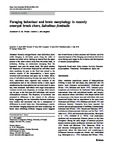Foraging behaviour and brain morphology in recently emerged brook charr, Salvelinus fontinalis
| dc.contributor.author | Wilson, Alexander | |
| dc.contributor.author | McLaughlin, RL | |
| dc.date.accessioned | 2018-05-09T10:36:36Z | |
| dc.date.available | 2018-05-09T10:36:36Z | |
| dc.date.issued | 2010-11 | |
| dc.identifier.issn | 0340-5443 | |
| dc.identifier.issn | 1432-0762 | |
| dc.identifier.uri | http://hdl.handle.net/10026.1/11463 | |
| dc.description.abstract |
Recently emerged brook charr (Salvelinus fontinalis) foraging in still-water pools along the sides of streams are either active, feeding on insects from the upper portion of the water column away from the stream bank, or sedentary, feeding on crustaceans emerging from the hyporheic zone near the stream bank. We tested whether the frequency of movement displayed by individual brook charr searching for prey in the field was related to the relative volume of the telencephalon, a brain region involved with movement and space use in fishes. Movement of individuals searching for prey was quantified in the field, individuals were captured and volumes of the telencephalon and of the olfactory bulbs, a brain region neighbouring the telencephalon but not implicated in space use, were measured. Individuals with larger telencephalon volumes moved more frequently on average while searching for prey in the field than did individuals with smaller telencephalon volumes. The frequency of movement was unrelated to differences in the volume of the olfactory bulbs, suggesting that the relationship between telencephalon volume and movement was not a consequence of differences in overall brain size. Demonstrating a correlation between foraging behaviour and brain morphology for brook charr exhibiting different foraging tactics suggests that diversification in brain structure and function could be important aspects of the foraging specialization believed to occur during early stages in the evolution and development of resource polymorphisms. © 2010 Springer-Verlag. | |
| dc.format.extent | 1905-1914 | |
| dc.language | en | |
| dc.language.iso | en | |
| dc.publisher | Springer Science and Business Media LLC | |
| dc.subject | Brook trout | |
| dc.subject | Brain volume | |
| dc.subject | Activity | |
| dc.subject | Resource polymorphism | |
| dc.subject | Personality | |
| dc.subject | Telencephalon | |
| dc.subject | Space use | |
| dc.title | Foraging behaviour and brain morphology in recently emerged brook charr, Salvelinus fontinalis | |
| dc.type | journal-article | |
| dc.type | Journal Article | |
| plymouth.author-url | https://www.webofscience.com/api/gateway?GWVersion=2&SrcApp=PARTNER_APP&SrcAuth=LinksAMR&KeyUT=WOS:000282823800018&DestLinkType=FullRecord&DestApp=ALL_WOS&UsrCustomerID=11bb513d99f797142bcfeffcc58ea008 | |
| plymouth.issue | 11 | |
| plymouth.volume | 64 | |
| plymouth.publication-status | Published | |
| plymouth.journal | Behavioral Ecology and Sociobiology | |
| dc.identifier.doi | 10.1007/s00265-010-1002-4 | |
| plymouth.organisational-group | /Plymouth | |
| plymouth.organisational-group | /Plymouth/Faculty of Science and Engineering | |
| plymouth.organisational-group | /Plymouth/Faculty of Science and Engineering/School of Biological and Marine Sciences | |
| plymouth.organisational-group | /Plymouth/REF 2021 Researchers by UoA | |
| plymouth.organisational-group | /Plymouth/REF 2021 Researchers by UoA/UoA07 Earth Systems and Environmental Sciences | |
| plymouth.organisational-group | /Plymouth/Users by role | |
| plymouth.organisational-group | /Plymouth/Users by role/Academics | |
| dc.identifier.eissn | 1432-0762 | |
| dc.rights.embargoperiod | Not known | |
| rioxxterms.versionofrecord | 10.1007/s00265-010-1002-4 | |
| rioxxterms.licenseref.uri | http://www.rioxx.net/licenses/all-rights-reserved | |
| rioxxterms.type | Journal Article/Review |


